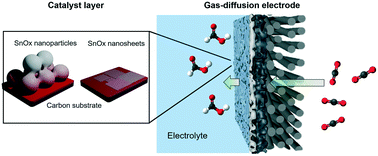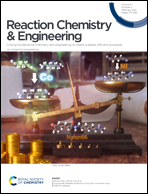Unveiling the effects of dimensionality of tin oxide-derived catalysts on CO2 reduction by using gas-diffusion electrodes†
Abstract
We report the effects of catalyst dimensionality on electrochemical CO2 conversion to formate by comparing the performance of tin oxide-derived 3D nanoparticles and tin oxide-derived 2D nanosheets deposited on gas-diffusion electrodes. Our results indicated that an extensive interface between the catalyst and the electrode substrate could lower the surface tin oxidation states and the hydrophobicity of the catalyst layer during CO2 electrolysis at a current density over 100 mA cm−2. This catalyst–substrate interfacial effect provides the nanosheets with a large interface area to become more selective for CO2 electrochemical reduction but with a higher overpotential requirement as compared to the 3D nanoparticle catalysts with limited interfacial area. Consequently, the electrode with nanosheets as the catalyst achieved a partial current density of formate at 116 mA cm−2 at a cathode potential of −1.03 V versus reversible hydrogen electrode, which is equivalent to a formate production rate of 36 μmol min−1 cm−2. Our work here demonstrates the importance of the catalyst–substrate interface in determining the oxidation states and wettability at the catalyst surface and the ultimate performance of the gas-diffusion electrode. These findings also have potential to guide the design of a catalyst–substrate to advance other important electrochemical processes such as fuel cells and water splitting.

- This article is part of the themed collection: Catalytic Membrane Reaction Chemistry


 Please wait while we load your content...
Please wait while we load your content...